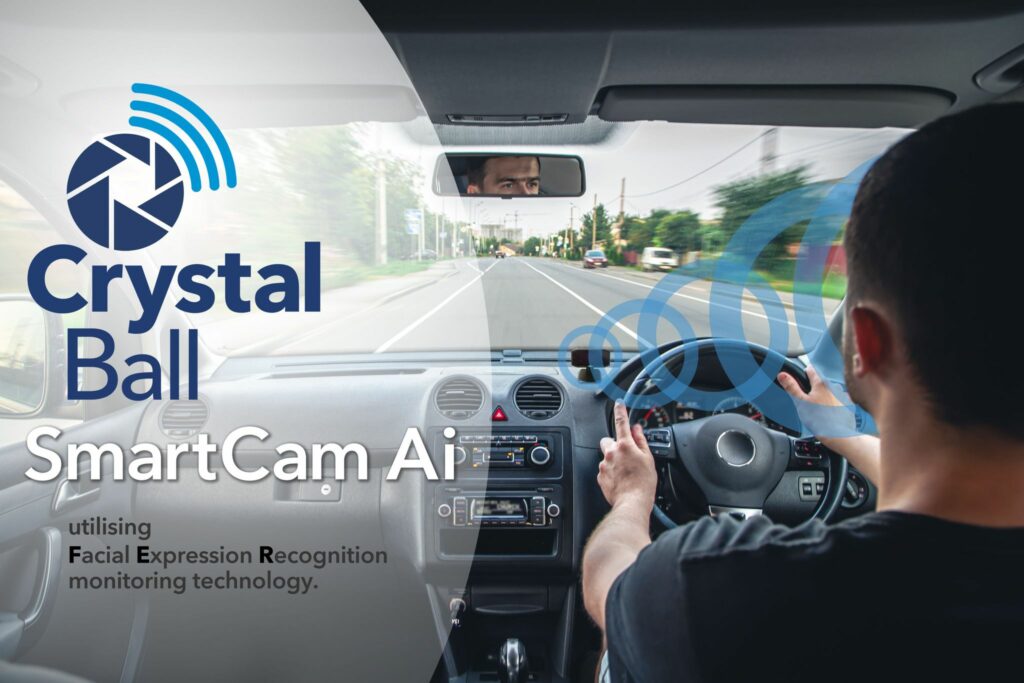Fleet managers face an ongoing challenge in maintaining the integrity of their fleet on the road. They rely on vehicle tracking systems to keep track of their fleet, with dash cam footage adding powerful visuals.
Dash cams have helped a lot in upping fleet safety and management efforts, and they’ve certainly come a long way since they were first introduced, and with time, they became smaller but grew in functionality, connectivity, and accessibility.
Initially, businesses with vehicle fleets utilised forward-facing cameras and, in some cases, cameras that provided activity coverage at the vehicle’s rear. But nowadays, it’s becoming a necessity for fleets to have inward-facing AI dash cams, as well.
How Do AI Smart Cams Minimise Road Risks?
The idea of having inward-facing AI dash cams pointed at drivers is not to undermine fleet personnel or invade their privacy. Instead, it’s a proactive way to capture, in real-time, any risky driver behaviour that could lead to an accident and ultimately it’s about their welfare and other road users .
For example, they’re useful for proactively detecting driver fatigue and risky behaviour, sounding an in-cab alert to give the driver a chance to correct their behaviour. Additionally, with time and location stamped HD footage stored in the cloud, fleet managers can access high-quality data to shed light on drivers’ behaviour surrounding specific incidents.
By proactively addressing road-related risks before they become problems, businesses with fleets of any size can enjoy increased productivity and fewer losses. It’s a no-brainer.
The Rising Need for Proactive Safety Measures to Reduce Accidents
Fleet managers are confronted with ever-increasing pressures to enhance the safety of their drivers and assets out in the field. Each incident with a company vehicle chips away at a company’s bottom line, whether due to stock loss, damage, insurance excess, a lawsuit, or paying damages to a third party. So, it’s best to eliminate the problems before they happen to maximise ROI. A dash cam, like Crystal Ball’s 4G AI SmartCam, pays for itself while boosting your business’s bottom line and enhancing driver safety.
Road accidents, near misses, and related incidents are typically a result of one or more of the following safety issues:
– Distracted driving caused by handling a mobile phone or other external factors.
– Fatigue from working extended hours or not living a healthy lifestyle.
– Speeding by driving too fast or too slow for conditions.
– Aggressive driving, such as tailgating or overtaking on dangerous curves.
– Inattention caused by distractions.
– Impaired driving, such as driving under the influence of drugs or alcohol.
– Poor vehicle maintenance, for example, the failure to check brakes or tyre pressure.
– Inadequate training for driving in snow, with a trailer, or other challenging conditions.
– External factors such as road hazards.
– Personal factors, including health or stress.
– Passengers and pedestrians who are jaywalking or acting unruly.
– Criminal activity like a hijacking or robbery.
Once the norm, reactive road safety measures pose significant challenges when dealing with the above risks. Relying solely on post-incident analysis and evidence leaves gaps in understanding. If there is evidence, it’s often subjective or flawed, making investigating an incident challenging.
For example, passengers in a cab might make false claims against a driver, but video evidence from its TfL-approved car camera shows what happened doesn’t correlate with their version of events.
That’s why early risk detection is paramount in addressing these challenges.
The shift in preventative behaviour marks a fundamental change in approach; it prioritises proactive measures above reactive responses. If you, as a fleet manager, opt to embrace early detection measures, you’ll be able to do the following:
– Foster a culture of accountability.
– Reduce road risks and incidents.
– Ensure the well-being of your drivers.
– Extend the operational longevity of your drivers and fleet.
How Do Inward-Facing AI Smart Cams Work?
Inward-facing dash cams are more than recording devices. They are advanced tools designed to monitor and analyse driver behaviour within vehicles. Broadly speaking, their function is similar to airport scanners in that they detect potential issues while protecting the subject’s privacy regarding data collection and display.
Using AI Smart Cams for Proactive Alerts and Warnings
A smart dash cam leverages artificial intelligence (AI) technology to detect potential risks and safety hazards in real time, offering proactive solutions to fleet managers. Some of the cutting-edge technology we use with our 4G Smart Cam includes intelligent facial recognition software.
This allows for real-time incident detection of various critical behaviours such as the following:
– Using a mobile phone instead of a hands-free or Bluetooth kit.
– Smoking while driving.
– Distracted driving (eyes looking to the left or right for too long).
– Falling asleep/eyes closing.
– Yawning.
– If the head is lowered into a sleeping position.
– When nobody is at the wheel while the vehicle is in motion.
Intervention Mechanisms
By coupling smart recognition capabilities with in-vehicle alerts, our AI dash cam detects high-risk situations in real time and immediately alerts the driver and the fleet manager. This allows the driver to take action and correct their behaviour, effectively reducing the risk of an accident while receiving coaching on the job. It also ensures the fleet manager is aware that there was an incident and that the driver has been made aware of it.
The Benefits of AI Smart Cam Preventative Safety Measures
Using an inward-facing AI dash cam comes with a host of benefits:
Reduction in Collisions and Fatalities
An AI-powered dash cam can identify and address risky behaviours and situations before or while they’re happening. Alerting drivers to their behaviour can prevent accidents and promote safe driving habits, leading to safer roads, traffic, and communities.
Cost-Savings for Individuals and Organisations
Preventing road incidents reduces financial burdens such as costly repairs, medical expenses, insurance claims, and legal fees. This significantly lowers costs for drivers and operators, improving their financial stability and sustainability.
Psychological Impact on Behaviour
When drivers know they are being monitored, it can encourage them to exhibit safer driving behaviours. The awareness of being watched promotes accountability and responsibility, leading to improved driving habits and reduced risk-taking on the road.
Improved Planning and Training
Fleet managers can use the footage to identify trends, implement driver training programmes, or alter shifts or routes. Drivers also receive training on the job, as they’re immediately corrected when they do something wrong. This is a huge benefit to fleet managers, as it targets drivers’ weak points and corrects them without spending extra time, resources, and money on separate training programs.
Cross-Sector Collaborations
Another benefit is that AI smart cams enable collaboration between drivers, fleet coordinators, and authorities to share real-time footage and alerts. With the footage collected from AI smart cams, authorities can get a holistic view of driver behaviour around accident hot spots and make data-driven decisions to reduce these challenges.
Challenges and Considerations of Inward-Facing Dash Cams
Understandably, there are challenges to consider when using inward-facing dash cams. These range from potential technical issues to privacy issues:
Technical Limitations
– Limited field of view: Managers should ensure their dash cams provide a comprehensive field of view and do not focus on only one direction. Ideally, cars, trucks, vans, or HGVs should be fitted with forward—and inward-facing dash cams at the very minimum.
– Reliance on connectivity: An AI dash cam requires reliable mobile connectivity to send data to the cloud for analysis. Business owners and fleet managers should invest in AI dash cam and fleet tracking systems that provide strong connectivity.
Privacy Concerns
– Transparent HR policies: Establish clear AI dash cam policies and communicate them openly to drivers to alleviate privacy concerns and foster trust.
– Data anonymization: Anonymise sensitive data (e.g., blurring or reducing image quality) to protect driver privacy while enabling safe monitoring. Additionally, choose cameras like our SmartCam that don’t record audio.
Regulatory Frameworks
– Compliance with data protection regulations: Fleets of any size using dash cams must comply with relevant data protection laws as laid out by the Information Commissioner’s Office. This typically involves obtaining consent from drivers for data collection and processing, plus implementing robust data security measures to safeguard sensitive information.
– Incorporating into HR policy: It’s important to ensure that your HR policy provides information to staff to help them understand the benefits that this technology provides and that it improves their safety, welfare and overall well being. It’s not intended to be an invasion of their privacy. The aim is to always improve their safety whilst at work and reduce the occurrence of road traffic accidents.
– Adherence to industry standards: To comply with regulations and standards, managers should stay updated on local AI dash cam usage standards and best practices through industry associations, training programmes, and legal experts.
Fad or Necessity: Are Dash Cams Here to Stay?
Given their immense potential to positively impact road safety, efficiency, and urban mobility, AI dash cams are here to stay. Until fleet vehicles become fully automated, inward-facing dash cams will continue to bolster fleet managers’ proactive efforts.
With data-driven insights, AI dash cams can help to promote a culture of responsibility among drivers, leading to improved driving habits, reduced risk-taking behaviours, and safer roads.
Preventative Safety Gets Smart
Inward-facing dash cams signify a transformative shift in fleets of every size, servicing every sector. They allow for proactive measures, accident reduction, and associated cost-saving. Additionally, they allow fleet managers to take preventative measures while fostering a culture of accountability among drivers.
Embracing driver-facing AI smart cams is the key to minimising road risks and ensuring safer driver experiences. By investing in these innovative solutions, managers can enhance road safety and realise significant ROI through reduced accident rates and improved operational efficiency.
Take the proactive step today towards safer roads and more efficient fleet management with AI smart cams. Contact the Crystal Ball team to learn more about how we can help minimise road risks using technology.


